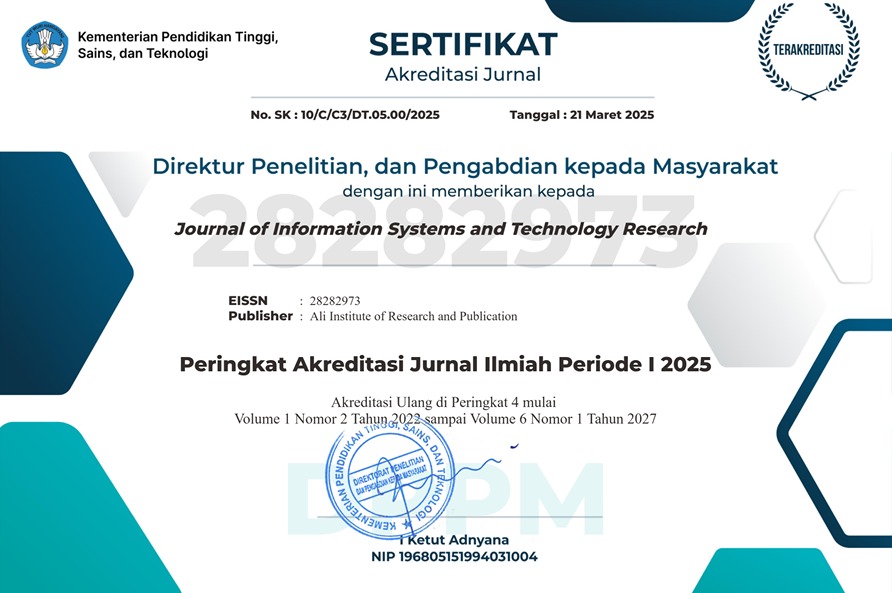Sales Forecasting Application Using The Triple Exponential Smoothing Method Based on Android
DOI:
https://doi.org/10.55537/jistr.v2i2.614Keywords:
Forecasting, Triple Exponential Smoothing, R&D, WaterfallAbstract
Forecasting is the art and science of predicting future events. This can be done by involving taking past data and placing it into the future with a form of mathematical model. The application of the Triple Exponential Smoothing Method is very appropriate to solve the above problems because the Triple Exponential Smoothing Method is used in short-term forecasting, usually only 1 month ahead. The Triple Exponential Smoothing method assumes that the data fluctuates around a fixed mean value, without an even trend or growth pattern. the author conducted research related to the calculation of the development of laptop purchases at CV.Gaharu.Com problems often occur, especially the problem of calculating laptop sales predictions such as the absence of a special system in calculating laptop sales in the coming period so that the company's stock often runs low and is not proportional to consumer demand which is growing rapidly and increasing, as well as in making laptop sales reports are still processed with a fairly simple application so that the reports obtained are less accurate. The research method used by the author is using the R&D (Research and Development) research method. The method of data collection was carried out in this study, namely by means of observation, interviews, and literature study. The steps taken are database design and describe the workflow of the application to be built using UML. At this stage the author designs the interface to produce an interface that is in accordance with the functions required for the application to be built. The system development method used by the researcher is the waterfall.
Downloads
References
Suendri, Triase, and S. Afzalena, “IMPLEMENTASI METODE JOB ORDER COSTING PADA SISTEM INFORMASI PRODUKSI BERBASIS WEB * Suendri ** Triase *** Siti Afzalena * Universitas Islam Negeri Sumatera Utara ** Universitas Islam Negeri Sumatera Utara *** Universitas Islam Negeri Sumatera Utara Sistem,” vol. 4, no. April, pp. 97–106, 2020.
H. Indrayani, “PENERAPAN TEKNOLOGI INFORMASI DALAM PENINGKATAN EFEKTIVITAS, EFISIENSI DAN PRODUKTIVITAS PERUSAHAAN Oleh : Henni Indrayani Abstraksi,” J. El-Riyasah, vol. 3, no. 1, pp. 48–56, 2018.
R. Fajri and T. M. Johan, “Implementasi Peramalan Double Exponential Smoothing Pada Kasus Kekerasan Anak Di Pusat Pelayanan Terpadu Pemberdayaan Perempuan Dan Anak,” J. ECOTIPE, vol. 4, no. 2, pp. 6–13, 2018, doi: 10.33019/ecotipe.v4i2.6.
S. N. Budiman, “Jurnal Teknologi dan Manajemen Informatika Peramalan Stock Barang Dagangan Menggunakan Metode Single Exponential Smoothing,” vol. 7, no. 2, pp. 113–121, 2021.
M. Qamal, “Peramalan Penjualan Makanan Ringan Dengan Metode Single Exponential Smoothing,” J. Penelit. Tek. Inform., vol. 8, no. 2, pp. 25–35, 2018.
H. Cipta, A. H. Hasugian, and A. Ikhwan, “KOMIK (Konferensi Nasional Teknologi Informasi dan Komputer) PERANCANGAN APLIKASI PENJUALANBUKU ONLINE DENGAN METODE MODEL VIEW CONTROLLER (MVC),” KOMIK (Konferensi Nas. Teknol. Inf. dan Komputer), vol. 1, no. January 2018, pp. 149–153, 2017, [Online]. Available: http://ejurnal.stmik-budidarma.ac.id/index.php/komik.
A. A. Setiawan, A. S. M. Lumenta, and S. R. U. A. Sompie, “Rancang Bangun Aplikasi Unsrat E-Catalog,” J. Tek. Inform., vol. 14, no. 4, pp. 1–9, 2019.
A. Fakhri, T. Hidayat, and Djamaludin, “Sistem Informasi Manajemen Pembudidayaan Ikan Lele Menggunakan Metode Research and Development,” JSiI (Jurnal Sist. Informasi), vol. 8, no. 1, pp. 53–58, 2021, doi: 10.30656/jsii.v8i1.3016.
A. Nurseptaji, “Implementasi Metode Waterfall Pada Perancangan Sistem Informasi Perpustakaan,” J. Dialekt. Inform., vol. 1, no. 2, pp. 49–57, 2021, doi: 10.24176/detika.v1i2.6101.
Suendri, “Implementasi Diagram UML (Unified Modelling Language) Pada Perancangan Sistem Informasi Remunerasi Dosen Dengan Database Oracle (Studi Kasus: UIN Sumatera Utara Medan),” J. Ilmu Komput. dan Inform., vol. 3, no. 1, pp. 1–9, 2018, [Online]. Available: http://jurnal.uinsu.ac.id/index.php/algoritma/article/download/3148/1871.
I. Akil, “Referensi dan Panduan UML 2.4 Singkat Tepat Jelas,” no. September, p. 196, 2018.
S. Julianto and S. Setiawan, “Perancangan Sistem Informasi Pemesanan Tiket Bus Pada Po. Handoyo Berbasis Online,” Simatupang, Julianto Sianturi, Setiawan, vol. 3, no. 2, pp. 11–25, 2019, [Online]. Available: https://journal.amikmahaputra.ac.id/index.php/JIT/article/view/56/48.
M Fahri Aditya Nasution, Suendri, and A. Muliani Harahap, “Customer Service Information System Using Dynamic Priority Scheduling Algorithm At PT Sumatra Sistem Integrasi,” J. Inf. Syst. Technol. Res., vol. 2, no. 1, pp. 25–37, 2023, doi: 10.55537/jistr.v2i1.324.
S. Kurniawan, T. Bayu, “Perancangan Sistem Aplikasi Pemesanan Makanan dan Minuman Pada Cafetaria NO Caffe di TAnjung Balai Karimun Menggunakan Bahasa Pemrograman PHP dan My.SQL,” J. Chem. Inf. Model., vol. 53, no. 9, pp. 1689–1699, 2020.
M. R. D. Wiradiputra, I. M. Candiasa, and D. G. H. Divayana, “Pengembangan dan PengujianSistem Informasi Manajemen Jalan Untuk Pemeliharaan Jalan DiKabupaten Buleleng Menggunakan Standar Iso 9126,” J. Ilmu Komput. Indones., vol. 6, no. 2, pp. 17–26, 2021.
Downloads
Published
How to Cite
Issue
Section
License
Copyright (c) 2023 Muhammad Ichsan Ichsan, Samsudin, Aninda Muliani Harahap

This work is licensed under a Creative Commons Attribution-ShareAlike 4.0 International License.







